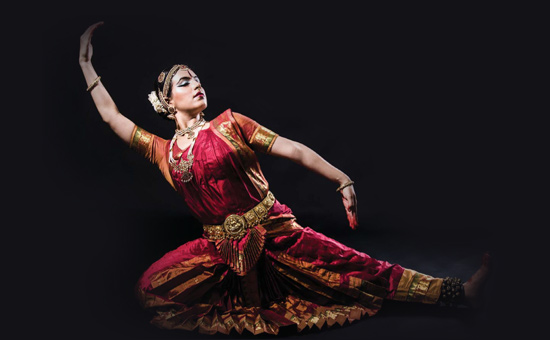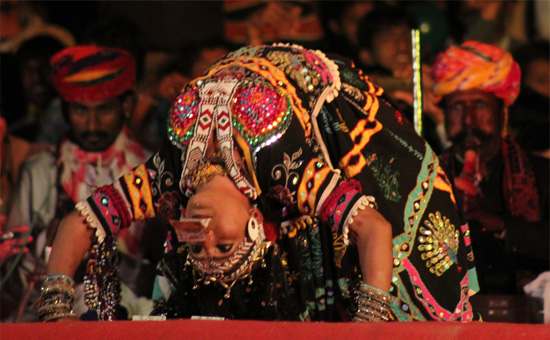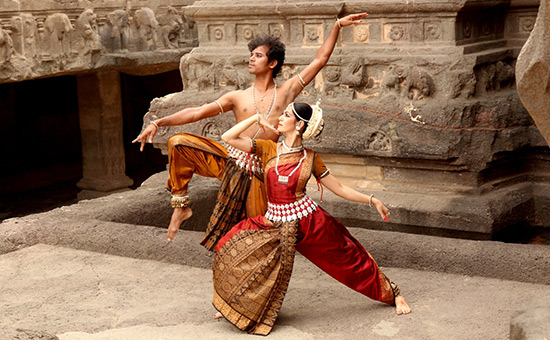-
Article
tells you about the development of Natya Sastra works across various parts of
India and from before B.C.
Like
the 64 arts, the origin of Bharatanatya Sastra is in Sanskrit. Saint Bharata
wrote this in 6000 slokas, in 36
chapters. It is widely believed that Saint Bharatha belonged to 300 B.C. He
learnt the art of dance from Nandikeswara and wrote elaborately about song,
drama and dance in his Bharatha Sastra.
Natya
Sastra was created by Brahma, as the ‘Fifth Veda’ by compiling the quintessence
of geetham (song), instrumental music
(vadhyam), dance (abhinaya) and rasa (emotions) found in the four Vedas.
The
first letters of the three words Bhava,
Raga and Thalam in Sanskrit (Bha+Ra+Tha=Bharatham), are linked together to
form the name ‘Bharatha’, the art of theatre. This is revealed in a play Sankalpa Suryodayam written by Sri
Vedantha Desika, who lived in 1300 A.D. Nandikeswara (300 A.D) wrote Bharatarnavam and Abhinaya Darpana in which he dealt elaborately about the art of
natya.
To
read the article in PDF click on PDF.
Article is courtesy Bhavan’s Journal.
Hari
Prasadha Sastry, Manavalli Ramakrishna Kavi, Manmohan Ghosh, P. V. Kane and Dr.
Geeth have mentioned Bharata’s period at 400-300 B.C. Nyaya Devar
Battalolludar, Acharya Kirthi who all lived from 600-1000 A.D. wrote the text
for Bharathasastra.
But,
translators from other languages, in their respective languages followed only Abhinava Bharathi, a work by a Kashmiri
Saiva religious scholar Abhinava Gupta (800 A.D.). For the first time,
Bharatanatya Sastra was published and released in 1894 A.D. in Kavya Mala
Series through Sivaprasada Sastri. Sroe of France published and released up to
14 chapters in 1898. In 1926, the University of Baroda published a book on
Bharatanatya Sastra penned by Manavalli Ramakrishna Kavi.
In
Sangam literature there is no specific mention about works on dance/dramas. But
subsequent authors have mentioned about works pertaining to Natya Sastra. This
is confirmed in Silappadhikaram,
which states that Madhavi performed her dance, strictly as per the Natya Sastra
(Nataka Nannool). There are authentic
evidences for this in literatures like Yapperungala
Urai, Vazhichezitriyam, Poigaiyar Nool, etc.
Researchers
thus conclude that there were several ancient writings on Dance/Drama, but they
all perished over time. We also find evidences in Tholkappiya literature viz., Nataka
Vazhakilum, Ulagial Vazhakilum,
which confirm that several writings in Tamil pertaining to Iyal, Isai and Natakam (Dance, Music and Drama) existed
even before Tholakappiar.
 Peruvian Bharatatyam
dancer.
Peruvian Bharatatyam
dancer.
In
Silappadhikaram, we find the greatness of dance. Ancient dancers were well
versed in all the 64 arts. Dance exclusively meant for the kings were
called Vethial. After the first
dedication ceremony in the King’s court, the dancers were conferred the titles Thalaikoil. The special features and
greatness of dance can be guessed from the paintings of ‘Siddhanna Vasal’ in Pudukottai district. The architectural and
sculptural beauties in the Vaikunta Perumal temple, Kanchipuram reveal the
grandeur of this ancient art.
In
the Telugu land, where the Vaidic religion existed during yagas and yagnas, gods
like Devadasi, Dig Balakas, Navagrahas, Panch Bhutams were worshipped in
different styles and forms of dance. Lord Shiva was known for worship through
various forms of dance. These can be seen in the Natya Sastra.
In
the Telugu land, where Buddhism prevailed, song and drama formed part of
worship. Buddhist devotees dedicated girls from their families solely for
performing dance before Gods and deities in temples. They were well trained in
song and dance and delighted the gods with their dances during festivals. These
girls were engaged in dance profession until they were married. After marriage
they gave up dancing and retired to lead a family life.
Sometimes
people were subjected to sufferings and great hardships due to estrangement
between celestial couples. To pacify and propitiate the gods and goddesses and
to get rid of the sufferings and troubles, damsels used to dance in the nude
form (Naknann Nruthyam) before the
deities.
By
doing so, the gods and goddesses were pacified and pleased to return to
normalcy and end the sufferings and hardships of the people. This was the
belief in those days.
We can see the various postures and forms of dance in the carvings,
sculptures in the Buddhist stupas in Amaravathi and the greatness and beauty of
sculptural works in the Nagarjuna Konda mountain caves.
In
1300 A.D. during the Kakatheeya regime, dance art flourished greatly in the
Telengana region. Joyf, the Commander-inChief
of the Kakatheeya King Ganapathy Devar, was a great hero, a man of great talent
and proficiency in art and dance. In his 60th year (1253-54), he wrote the
famous Natya Sastra known as Niruthya
Rathnavali, in which he dealt with Bharathanatyam and all other traditional
forms of dance that were in vogue in his country. There are several
similarities between the formal Sastra Natyas and the traditional street folk
dances.
 Kalbelia dance Marwar, Rajasthan.
Kalbelia dance Marwar, Rajasthan.
Researchers
consider dramatist Bhasa as a pioneer
in drama literature in Sanskrit. He dates back to poet Kalidasa. His dramatical
works bear a testimony to the fact that he is proficient in Natya Sastra. He
belonged to 300 B.C. From this one can conclude
that Bharathanatya Sastra had its origin in 200 B.C.
Kalidasa
(100 A.D.) wrote the Sanskrit drama Malavikagini
Mithiram, in which he portrays a dancer as the heroine. Here he narrates
in detail, her various forms of dance which means that even prior to Kalidasa
(100 A.D.) the Bharathanatya Sastra existed.
Poet
Manavalli Ramakrishna collected palm leaf manuscripts pertaining to
Bharathanatya Sastra. He conducted extensive research and brought out a
publication through the Baroda University. Most palm leaves collected by him
belong to South India. As a Reader in Tirupati Venkateswara Oriental Research
Institute, he brought out a book named Bharatha
Kosam. It is evident that Bharathanatyam was widely familiar in South India
in those days.
The Natya Sastra was created by the trio, Sadhasivar,
Brahma and Bharathar. Each contributed 30,000, 12,000 and 6,000 slokas respectively. It is not the
beginning nor was it the original. It is a guide book. Gowri, Vasuki, Saraswathi, Narada, Agasthiya, Vyasa and
the disciples of Bharatha contributed in the creation of Bharatha Sastra, says
Sarada Dhanayar in his book, Bhava
Prakasika. Vedic religion did not patronise Bharathanatya.
Natya
Sastras says that the art of dance is divine and was the creation of Brahma.
Yet, srutis, smrutis and other Dharma Sastras ridicule dancers and heap insults
on those partaking in dances as mere actors. The Artha Sastra even bars
building houses in the centre of a town and other important places for actors
and performers of dance and allied artists.
Singers,
dancers and storytellers known as Kusalavas,
were dubbed as people with bad character in some sastras.
According
to Vyakkiya Valgiya Smruthi it is no
offence to have sexual relationship with the wife of a person with acting as
his profession. Another smruthi says a Brahmin should not dine with an actor.
To cap it all, Saint Patanjali (200 B.C.) in his Bhashyam, defines a wife of an
actor as a public property. Is it not a paradox to declare dance as a divine
art and Natya Sastra as Natya Veda
and at the same breath, rule that nobody should practise it, and insult those
who practise it as outcasts?
 Odissi dancer with her Guru.
Odissi dancer with her Guru.
Thus Natya Sastra is full of contradictions! This is perhaps,
attributed to the fact that it was created by those belonging to the Aryan way
of life and that is why sruthi and smruthi which insist strict adherence to
Vedic culture abhors dance and those engaged in it. There is no evidence to
confirm that except Bharatha, none following Vedic culture learnt this art.
In
Bharatanatya Sastra (concluding a portion of Chapter 36), Saint Bharatha is
said to have told the other saints who learnt the art from him the following
incident:
Once,
the 100 sons of Saint Bharatha after learning the Natya Veda started ridiculing
and teasing other saints through dramas full of witty, derogatory and funny
sequences known as Prahasanas. They
enacted a play portraying improper and immoral sexual characters. Portraying
saints in the most despicable manner provoked by the dastardly behaviour of
Bharatha’s sons, all saints joined together and cursed them in anger and
indignation as follows:
“Oh,
Brahmins! You have insulted us and caused us humiliation and disgrace through
your words and deeds. You will lose mental faculties and talents. Though you
are Brahmins you will lose all your dharma, charm, sanctity of the Gayatri
mantra! You will become ignoble and no longer be called Brahmins. You and your
dynasty shall be ignomious. Your sons and daughters will become actors and be
treated as outcasts unfit to dine with others. You will fall from grace and be
dependent on others even for your livelihood.”
Consequent
to this, Bharatha’s 100 sons suffered serious decline. Later, Saint Bharatha
consoled them saying that there is no escape from the Saints’ curse and that
could not be wished away. He told them further that the Natya Veda would never
be destroyed and would flourish.
Saint
Bharatha did not suggest a remedy or recourse to the curses of the Saints to
his sons. It seems he himself admitted that the actors were characterless and
condemned people. The high respect and esteem ascribed to the Natya Sastra at
the beginning of the chapter was reversed in the end. Failure or the
intransigence of the vaidic and other
sastras to absorb the fine qualities of this great art resulted in the sharp
decline of this Sastra.
This article was first published in the Bhavan’s Journal, 31 May 2020 issue. This article is courtesy and copyright Bhavan’s Journal, Bharatiya Vidya Bhavan, Mumbai-400007. eSamskriti has
obtained permission from Bhavan’s Journal to share.